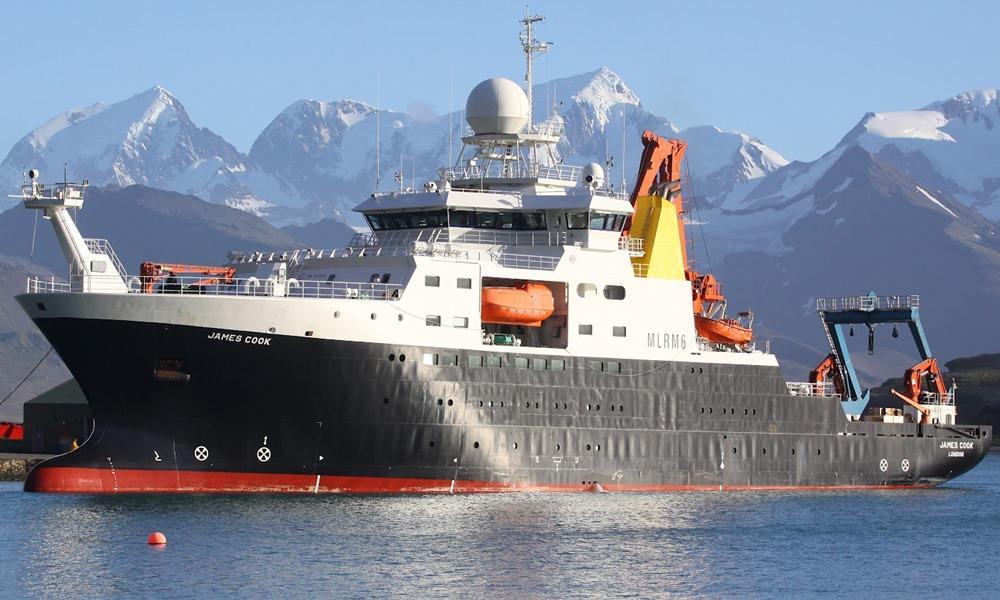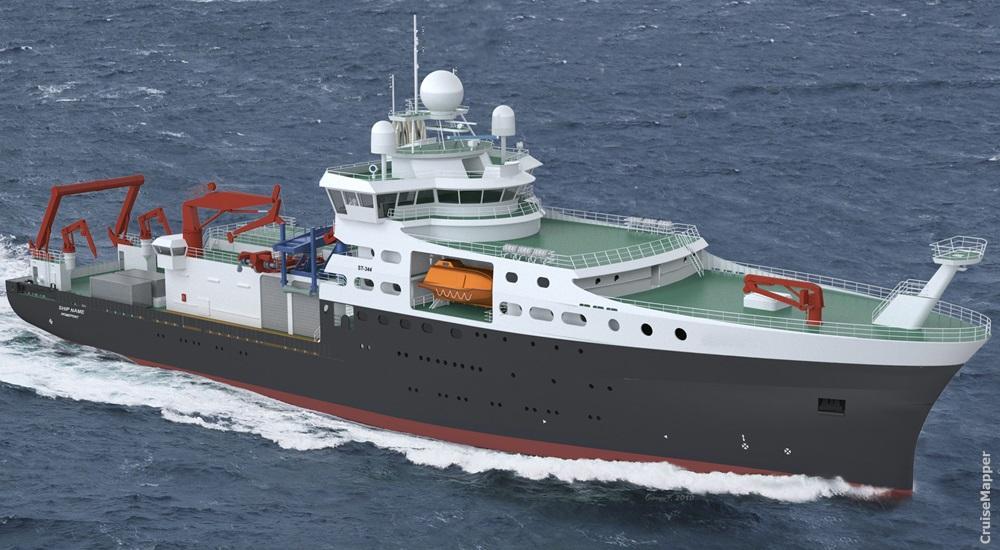RRS James Cook
RRS James Cook current position
The current location of RRS James Cook is in West Africa (coordinates -5.80392 S / 10.91239 E) cruising en route to NA WVB>AO LAD. The AIS position was last reported 3 minutes ago.
Current PositionSpecifications of RRS James Cook
| Year of build | 2006 / Age: 19 |
| Flag state | United Kingdom |
| Builder | Flekkefjord Slipp & Maskinfabrikk (Flekkefjord, Norway) |
| Class | ice-strengthened research ship |
| Building cost | GBP 36 million (USD 50 million) |
| Speed | 16 kn / 30 km/h / 18 mph |
| Length (LOA) | 90 m / 295 ft |
| Beam (width) | 19 m / 62 ft |
| Gross Tonnage | 5401 gt |
| Passengers | 32 |
| Crew | 22 |
| Decks | 7 |
| Decks with cabins | 2 |
| Christened by | HRH Anne (The Princess Royal) |
| Owner | UK government (NERC) |
RRS James Cook Review
Review of RRS James Cook
The 2007-built RRS James Cook ship is an ice-strengthened research vessel serving as oceanographic survey ship homeported in Tilbury-London (England UK). Its sistership (with a similar design) is RRS Discovery (launched in 2013). RRS stands for "Royal Research Ship".
Royal research ships are the UK's merchant navy vessels conducting scientific research for the British Government (HMG). The list of organizations that are allowed to operate RRS vessels includes NERC (abbrev "Natural Environment Research Council"), BAS (abbrev "British Antarctic Survey") and NOC (abbrev "National Oceanography Centre"). However, a warrant from the British monarch has required a vessel to be designated as RRS. The UK's current fleet of Royal Research Ships includes the following vessels (the year built in brackets): RRS James Cook (2007), RRS Discovery (2013, sistership) and RRS Sir David Attenborough (2021).

This British research vessel is operated by the UK government agency NERC (abbrev from "Natural Environment Research Council"). The vessel is named after Captain James Cook (1728-1779) - British Navy captain, explorer, and cartographer.
RRS James Cook vessel details
This research ship features an ice-strengthened double hull and containerized labs that can be equipped depending on the nature of scientific activities on each cruise. The ship also has an advanced hydroacoustic system consisting of 2 echosounders plus 1 hydrophone (on the keel) and can operate one ISIS ROV (remotely operated underwater vehicle / robotic submarine) with max working load 4,5 tons.

- The vessel is also has installed: dynamic positioning system, CCTV monitoring equipment, echosounder units by the Norwegian company Kongsberg Maritime (multibeam deepwater model EM122, multibeam medium-water model EM710, single-beam model EA600), sub-bottom profiler (model Kongsberg SBP120), scientific echo sounder (model Simrad EK60), cargo-deck aft articulated crane (17 m, model Ferri Serie A6 100170, single pull 10 tons, double pull 20 tons), hydraulic winch (10 tons pull, wire length 500 m / 1640 ft), knuckle crane (forward, Ferri Serie A0 020120, 12 m, 2 tons). A longitudinal transfer gantry crane (10 tons) is used to lift heavy equipment and TEU containers from the aft cargo deck and load them into the hangar. One 5-ton gantry crane is used for ROV deployment.
- The ship is powered by four "Wartsila 9L20" marine diesel engines (combined power output 7080 kW).
- Propulsion is diesel-electric and provided by two Teco Westinghouse diesel generator sets (combined output 5000 kW). The ship has all five thrusters (each with 5-bladed fixed pitch propellers) - one retractable (bow, power output 1200 kW), one Azimuth (360-degree, power output 1350 kW) and two stern fixed thrusters (one 1600 kW, one 800 kW).
- Displacement tonnage: 5800 tons
- Deadweight tonnage: 2463 tons
- Max Draught: 5,7 m (19 ft) fully loaded
- Ice-class: 1C (ice-strengthened bow)
- Endurance: 50 days
- Capacity: 54 passengers and crew
- The ship has no helipad and can't serve helicopters.
Note: In the case of poor AIS coverage, tracking the vessel's current location will be impossible. You can see the CruiseMapper's list of all icebreakers and ice-breaking research ships in the "itinerary" section of our Icebreakers hub. All states and their fleets are listed there.
Other UK cruise ships
RRS James Cook Wiki
RRS James Cook ship's superstructure was built by the Norwegian shipbuilder "Flekkefjord Slipp and Maskinfabrikk AS". The hull was constructed at the Gdansk Shipyard (in Gdansk Poland).
The vessel's design was developed by the Alesund Norway-based company Skipsteknisk (also the designer of RRS Discovery).
The ship was christened in February 2007 by godmother HRH Anne Elizabeth Alice Louise (Princess Royal).
This top-notch scientific research ship operates on worldwide scientific cruise itineraries. It specializes in measurements related to oceanic marine life (ecosystems) and seismic surveys (underwater earthquakes). In March 2007, while operating in the Caribbean Sea, the James Cook ship discovered the world's deepest undersea volcanic vents. Another important discovery was made in September 2015. While studying the Whittard Canyon's seabed (Bay of Biscay), the ship pictured the first blue whale (baleen whales) in British waters since these northeast Atlantic marine mammals were almost hunted to extinction.
